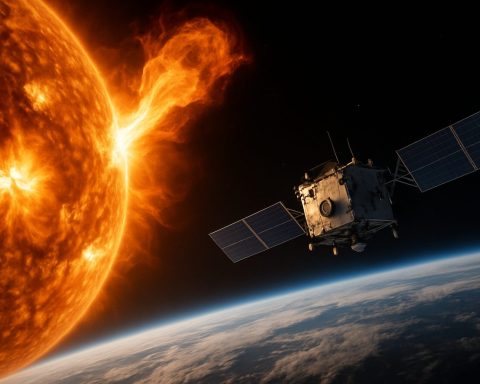The excitement is palpable as President Trump charts an ambitious course for space exploration. During his recent second inaugural address, he announced plans to send astronauts to Mars, elevating America’s aspirations beyond Earth. He spoke passionately about the nation’s potential, emphasizing the need to explore the cosmos and symbolically plant the American flag on the Martian surface.
Seated nearby, Elon Musk, the head of SpaceX and a close ally of Trump, enthusiastically responded to the speech with a thumbs up, reflecting his alignment with the ambitious vision for space travel. This declaration could represent a significant shift in federal focus towards Mars, complementing SpaceX’s objective of making human settlement on the planet a reality.
As SpaceX continues the development of Starship, the world’s largest rocket, there are regulatory hurdles to overcome, especially regarding environmental concerns at the testing site in Texas. Under the new administration, Trump may consider easing these regulations to expedite progress.
NASA is also making strides with its Perseverance rover on Mars, working on innovative methods to retrieve precious samples. Meanwhile, Musk recently mentioned a unique project related to the administration’s cost-cutting initiative. His vision is encapsulated by the dream of American astronauts making history on another planet, which would inspire generations to come.
The Broader Horizon: Space Exploration’s Impact on Society and Environment
The ambition to colonize Mars transcends mere space exploration; it signifies a potential paradigm shift in human endeavor that could redefine societal and cultural boundaries. As nations grapple with terrestrial challenges—climate change, resource scarcity, political discord—the vision of interplanetary settlement may serve as a unifying goal, fostering international collaboration. This quest for a shared celestial future invites a rekindled interest in STEM fields, encouraging a new generation of scientists, engineers, and thinkers while simultaneously nurturing a sense of global citizenship that extends beyond Earth.
Nevertheless, the environmental implications of intensified space exploration must be critically examined. The ecological cost of rocket launches, particularly from sites like SpaceX’s facilities in Texas, raises alarms regarding air quality and wildlife disruption. Furthermore, creating a human presence on Mars poses challenges such as resource exploitation and potential contamination of extraterrestrial environments. As we pursue ambitious space policies, sustainability must remain at the forefront of these discussions.
Looking ahead, the trajectory of human exploration beyond Earth hints at future trends in commercial space travel and international partnerships. With entities like SpaceX leading the charge, space may no longer be the ultimate frontier but a potential economic sector, fostering innovation and creating jobs. The long-term significance of these endeavors could redefine humanity’s relationship with its home planet and the universe, urging us to contemplate not just our dreams of conquest, but our responsibility as stewards of both Earth and beyond.
Trump’s Vision for Mars: A New Era of Space Exploration
Introduction
The landscape of space exploration is witnessing a transformative phase, driven by ambitious plans articulated by President Trump during his second inaugural address. With a daring goal of sending astronauts to Mars, the administration is setting its sights beyond Earth, aiming to inspire a new generation of explorers. This vision aligns closely with the efforts of private aerospace players like SpaceX, spearheaded by Elon Musk.
Key Features of the Mars Mission
1. Human Settlement Aspirations: President Trump’s vision includes bold plans for not just visiting Mars but establishing a human presence on the planet. This ambition is characterized by a desire to “plant the American flag” on Martian soil, symbolizing national achievement in the realm of interplanetary exploration.
2. Collaboration with Private Sector: The partnership between governmental entities like NASA and private corporations such as SpaceX is crucial. This collaboration aims to merge public objectives with private innovation, potentially accelerating technological advancements.
3. Technological Innovations: SpaceX is actively developing the Starship, which is heralded as the largest rocket ever built. This spacecraft is designed to be fully reusable and capable of carrying humans and cargo to a variety of destinations beyond Earth.
Pros and Cons of the Mars Mission
Pros:
– Innovation in Technology: Investment in space exploration can lead to technological advancements that benefit other industries.
– Inspiring Future Generations: Major milestones in space can ignite interest in STEM fields among young people.
– International Prestige: Successfully landing humans on Mars would enhance the United States’ status as a leader in space exploration.
Cons:
– Environmental Concerns: The development and testing of rockets may face opposition due to potential environmental impacts.
– High Costs: The financial implications of Mars missions may detract from other critical areas of federal spending.
– Technical Risks: Space travel inherently carries risks, and failures could deter public support for future missions.
Use Cases of Space Exploration Technologies
– Satellite Technologies: Advances in space technology often translate into improvements in satellite communications, weather forecasting, and earth observation.
– Scientific Research: Missions to Mars provide opportunities for groundbreaking scientific discoveries, enhancing our understanding of planetary science.
– Potential for Resource Utilization: Mars exploration could focus on the possibility of in-situ resource utilization (ISRU), which is essential for sustainable human presence.
Limitations and Challenges
Despite the exciting prospects, there are significant challenges to overcome:
– Regulatory Hurdles: Current environmental regulations may slow down the rapid progress desired by the Trump administration and SpaceX. Easing these regulations could pose ethical dilemmas.
– Public Opinion: Gaining and maintaining public support for major space initiatives is critical, especially in the face of domestic priorities.
– Logistical Issues: The vast distance to Mars presents unique logistical challenges, from life support systems to travel duration and health impacts on astronauts.
Trends and Innovations in Space Exploration
– Increased Private Investment: There is a growing trend of private investment in space exploration, allowing for advancements that might have been previously constrained by government budgets.
– International Collaboration: Countries worldwide are increasingly collaborating on space missions, which could lead to more innovative approaches to challenges on Mars.
Security Aspects
As with any major exploration, national security and technological superiority play a critical role. Space capabilities are vital for both defense strategies and international relations. Efforts need to ensure that technology is developed responsibly and securely.
Conclusion
The pathway to Mars is fraught with challenges but rich with opportunities that could redefine humanity’s future in space. With plans put forth by President Trump and the enthusiasm of innovators like Elon Musk, the vision of human exploration beyond Earth is becoming a tangible goal. As the dynamics of space exploration evolve, it promises to be a fascinating journey for both the adventurers onboard and the generations inspired by their courage.
For more insights on the future of space exploration, check out NASA’s official website.














